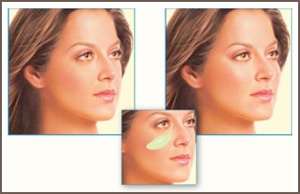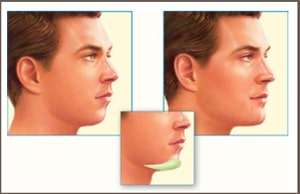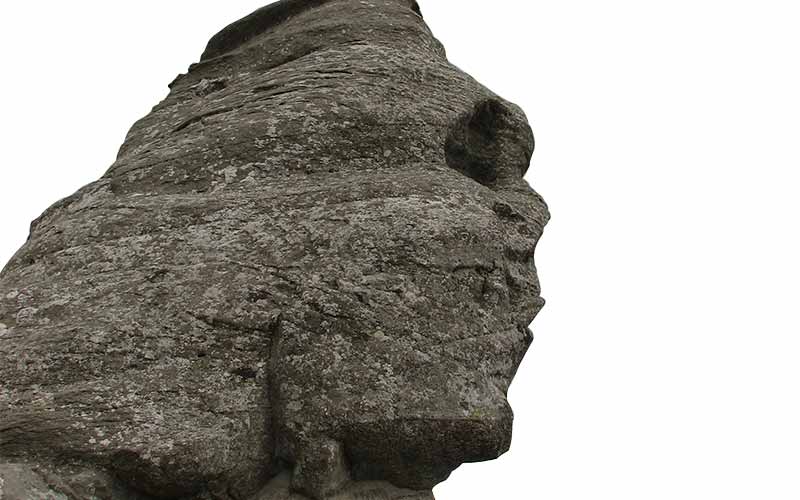facial implants
The goal of facial implants is to restore, enhance or create attractive structural foundation to the face.

BEFORE AND AFTER BOTH CHIN AND JAW (MANDIBULAR ANGLE) AUGMENTATION
[accordion openfirst=”true” clicktoclose=”true” scroll=”true”]
[/accordion]
Terminology Notes for Facial Implants
Facial implants offer permanent structural improvement or balance to the face. Made from safe, solid, surgical-grade silicone or Medpor® (polyethylene), they’re custom chosen and fitted by Dr. Haworth to perfectly suit you and your face for the most natural look possible.
SITES INCLUDE:
 CHEEKS (malar augmentation) to impart a glamourous look to an otherwise flat and bland midface. Emphasis can be placed on either lateral augmentation, anterior augmentation (to suggest an “apple shaped” cheek below the eyes) or both.
CHEEKS (malar augmentation) to impart a glamourous look to an otherwise flat and bland midface. Emphasis can be placed on either lateral augmentation, anterior augmentation (to suggest an “apple shaped” cheek below the eyes) or both. CHIN (genioplasty) to bring the silhouette forward as a supplement for a weak chin. With sophisticated placement techniques, the chin may not only be advanced forward, but also elongated and widened. In contrast, Dr Haworth will occasionally modify the actual jawbone to reduce an elongated and/or wide chin. Of course, no implants are utilized in this case.
CHIN (genioplasty) to bring the silhouette forward as a supplement for a weak chin. With sophisticated placement techniques, the chin may not only be advanced forward, but also elongated and widened. In contrast, Dr Haworth will occasionally modify the actual jawbone to reduce an elongated and/or wide chin. Of course, no implants are utilized in this case. JAW (mandibular enhancement) to create a more defined or more masculine jaw line. Alternatively, these are often used to better balance a narrow lower third of the face.
JAW (mandibular enhancement) to create a more defined or more masculine jaw line. Alternatively, these are often used to better balance a narrow lower third of the face.RELATED PROCEDURES
Facial implants impart bony structure. Soft tissue augmentation or implantation, on the other hand, generally consists of injected “fillers” that smooth contours, fine lines, folds and wrinkles.
These include:
- Long-lasting fillers which include Fat transfer and Artefill® . These can provide beautiful and natural results from semi-permanent to permanent, depending on a variety of factors
- Temporary fillers (Restylane®, Juvederm ® XC, Radiesse®,etc.) that give a pleasing outcome which only persists between 6 -18 months.
Patients may choose to have facial implants on their own or in conjunction with other procedures such as a face lift, lip reshaping surgery, brow lift, eye lid lift or fat transfer.
EXPECTATIONS
Of course, individual results can vary, but malar augmentation will deliver a balanced and/or rejuvenated look that will last permanently. However, as time goes by and gravity takes its toll the rest of the face will continue to age. The actual malar ( cheek) fat pads will continue to sag despite the presence of cheek implants necessitating other surgery if correction is desired. There is a common misconception that malar implants with considerably lessen nasolabial folds or substitute for a midface lift- this is not true Chin and jaw implants ( Taylor mandiibular angle to give a defined, wider jawline) will have a lasting benefit despite the aging process. Significant weight gain may blunt the visual benefits of these facial implants while significant weight loss may exaggerate an otherwise gaunt look by emphasizing the disparity between the peaks and the valleys of the face.
Candidates for Facial Implants
The most appropriate candidates for facial implants are:
- Patients whose faces look sunken or tired
- Older patients who seek youthful, structural enhancement in conjunction with other procedures
- Patients with weak, thin or undefined features who wish more defined and pleasing facial contours
- Patients with naturally unbalanced or asymmetrical features whether they be attributed to soft tissue or skeletal imbalance
What facial implants cannot do is:
- Fill in fine lines and wrinkles
- Fill in skin that is loose, slack or draped. In other words, facial implants cannot substitute for a facelift when a facelift is what is needed. Do not expect cheek implants to erase the nasolabial folds or a chin implant to tighten a loose neck.
NEW TECHNIQUES VS. OLD THINKING
Our understanding of facial implants has become more sophisticated than in generations past, resulting in a far more subtle, natural outcomes than ever before.
These breakthroughs include:
- CUSTOM SCULPTING TO FIT: there are a plethora of available implants suited for most anatomical variations. They differ not only in size but also in shape, often in very subtle ways. It is up to the surgeon to chose the appropriate implant most suitable for idiosyncratic skeletal topography and the individual goals of the patient. Furthermore, the skilled surgeon may go so far as to “super-customize” an implant by carving subtleties in it to address unique anatomical nuances each patient may possess.
- CUSTOM PLACEMENT FOR EXPRESSION: skilled surgeons will not just place an implant flatly over a bony prominence, they will angle and tilt it in order to impart and enhance particular feminine or masculine facial contours.
- IMPROVED UNDERSTANDING OF THE BIO-MECHANICS OF IMPLANTS: as a result, increased safety with less infection , movement and asymmetries has arisen with less need for revisional surgery. Facial implants, when properly seated, feel almost indistinguishable from your own bone.
PRE-OPERATIVE CONSULTATION
The pre-operative consultation is where you meet with Dr. Haworth and our staff to review your health, finalize the details of your procedures, order appropriate tests, prescribe medications, discuss your aftercare and answer any questions you may have.
All patients are required to take standard blood tests within 6 weeks of surgery.This can be arranged at the same time as your pre-op consultation.
To the consultation, we ask that you bring the following if possible:
- Any appropriate health records related to the list of conditions noted above.
- Photographs of you when you were in your teens, twenties and thirties
For patients over 45, we may also require that you provide the following:
- full medical clearance
- EKG
Alternatively, we can coordinate this for you.
CRITICAL PRE-OP CAUTIONARY NOTE
It is absolutely essential that that you avoid all aspirin, aspirin-related, ibuprofen or blood-thinning medications for 2 full weeks prior to your surgery. In your pre-op consultation, we will give you a complete list of these drugs. For our patients, we also provide a password-protected link allowing you to download the list onto your computer. If in doubt about a specific medication, do not take it, call the office first and ask if it is on the forbidden list.
PROCEDURE AND RECOVERY LOGISTICS
CHIN IMPLANT
SURGERY DURATION: 30-45 minutes. Dr Haworth will often perform liposuction under the chin simultaneously with the chin augmentation to compliment the aesthetic outcome.
ANESTHESIA: Sedated.
ONE SUTURE REMOVED: 3-5 days
JAW IMPLANT
SURGERY DURATION: 60 minutes
ANESTHESIA: General or sedation (“twilight sleep”) we will do everything we can to keep you comfortable. An anti-emetic (against nausea) medication is also administered while you are asleep. We not only provide pain medication to control what little pain you may experience postoperatively, but you will be additionally prescribed anti-anxiety, anit-nausea and sleeping pills to maximally ensure your comfort and safety
SUTURES REMOVED: None since Dr Haworth employs dissolvable sutures in the mouth
CHEEK IMPLANT
SURGERY DURATION: 60 minutes
ANESTHESIA: Sedated.
SUTURES REMOVED: None since Dr Haworth employs dissolvable sutures in the mouth
As you wake up from surgery, you will most likely be numb for a number of days around the surgical site, but this will gradually return to normal with 2-6 weeks. Swelling peaks between the first and second day after surgery. Bruising is generally not severe in these cases.
By the third week, you’ll look and feel much better. Most patients are back at work about ten days to two weeks after surgery. If you need it, special camouflage makeup can mask most bruising that remains.
Gradually, you will be able to resume to your normal activities:
- 1-2 DAYS read or watch television
- 3-5 DAYS resume wearing makeup (most bruising will be gone).However, you will most likely still be quite swollen for another week or so.
- 3-21 DAYS be out in public, back to work and take long strolls. Patients undergoing chin augmentation tend to heal very quickly and are often out-and-about the next day after surgery. Jaw and cheek implantation take longer to heal from
- 2-3 WEEKS begin moderate and work up to vigorous exercise.
MINIMIZING SCARS
Save for the very small scar under the chin associated with chin augmentation, scars resulting from malar and jaw implantation are located in the mouth.
POST-OPERATIVE CARE
If you are having facial implants done in conjunction with other procedures, follow the post-op instructions for the more extensive surgery. Otherwise, you will need to keep your activities to a minimum for at least 3 to 5 days.
In person and in your post-op information packet, we shall explain everything you need to know for your aftercare at home that will include:
- medications (prescription and homeopathic)
- cleaning incision sites
- Item
Expect to tire easily for awhile, especially if you had jaw implants. To aid your recovery you’ll want to rest as much as possible and:
- Treat your face gently, since your skin will be both tender and numb
- Rinse your mouth with a 1:1 mixture of hydrogen peroxide and water three-four times per day. Brush your teeth with a small electric toothbrush.
- Take your antibiotics for the prescribed period of time. You will additionally be given pain medication and medicine to specifically help reduce your swelling.
- If you had jaw augmentation, expect some stiffness when attempting to fully open your mouth. This will subside and Dr Haworth may recommend certain exercise to speed the resolution of this temporary limitation.
- Keep your head slightly elevated ( above the level of your heart)- even while sleeping – for as long after bothersome swelling persists. This posture will expedite your healing even up to two weeks after surgery
- Avoid strenuous activity – including exercise, sex and heavy housework – for at least 1-2 weeks. Engaging in these activities too soon may create extra needless swelling.
- Avoid steam baths, and saunas for at least two weeks or until the doctor gives you the OK
- Avoid alcohol and aspirin products for two weeks before and after surgery. Our office will provide you with an exhaustive list of medications, herbs and nutritional supplements to eschew during the same time frame.
- To optimize and accelerate healing, we also recommend coming into the office for hyperbaric oxygen treatments and Bioptron™ polarized light therapy. Both of these modalites can reduce swelling and bruising by up to 5-7 days. Addtionally, these exhibit signicant healing properties upon slow-healing incisions and injured skin.
RISKS & CHALLENGES
Conditions that make cheek implants more of a challenge and may require additional tests and workup from the appropriate medical specialist include:
- uncontrolled high blood pressure
- blood clotting problems
- smoking
- dental decay or edentulous ( no teeth) state
- advanced resorption of the jawbone
No surgery is entirely risk-free. However, both our staff and facilities have the highest possible qualifications and dedication to produce a happy outcome.
While risks and complications are uncommon, be aware that those for facial implants can include:
- Slight shifting of the implant
- Asymmetry
- Numbness or discomfort ( rare)
- Infection (necessitating temporary removal of the implant)
- Exposure of the implant (rare)
- Minor changes of the underlying skull or jaw with time (basically inconsequential, however)



